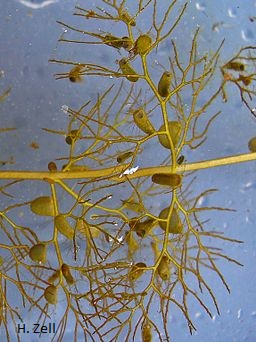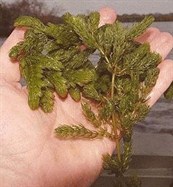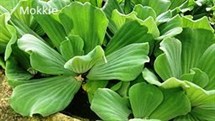Product Overview
Alligare® Diquat Herbicide is a contact herbicide used to control aquatic weeds in public waters such as ponds, lakes, reservoirs, marshes, bayous, drainage ditches, canals, streams, rivers, and other slow-moving or quiescent bodies of water.
Alligare® Diquat Herbicide contains 37.3% Diquat Dibromide
Begins to Work on Contact for No-Wait Control
Alligare® Diquat Herbicide is a contact herbicide rapidly absorbed by target plants within minutes of application. Alligare® Diquat Herbicide also rapidly kills undesirable above-ground weed growth in 24 to 36 hours. Avoid application to desirable plants. It is essential to obtain complete coverage of the target weeds to get control.
Alligare® Diquat Herbicide is Labeled for Use Against:
(click on the desired weed for more information and alternate control options)
 |
 |
 |
 |
|
(Utricularia spp.) |
(Ceratophyllum demersum) |
(Elodea spp.) |
(Lemna spp.) |
 |
 |
 |
 |
|
(Pithophora spp & Spirogyra spp.) |
(Hydrilla verticillata) |
(Najas spp.) |
(Salvinia spp. including S. molesta) |
 |
 |
 |
 |
|
(Ranunculus flabellaris) |
(Pistia stratiotes) |
(Eichhornia crassipes) |
Water Pennywort (Hydrocotyle spp.) |
For very dense submersed aquatic plant populations, resistant species and certain types of algae, it is manufacture recommended to use Alligare® Diquat Aquatic Herbicide in combination with an approved tank-mix partner. Approved tank mix partners include: Clearigate, K-Tea, Komeen, Cutrine Plus, Aquathol K and Hydrothol 191.
Application
Alligare® Diquat Herbicide is effective anytime it is applied to live foliage that is reasonably developed, but before growth becomes too dense or weeds flower. Application rates vary; refer to the label for the target plant dosage rates required. Mix the required amount of Alligare® Diquat Herbicide with pond water according to label instructions preferably on a sunny day. When exposed to light, Alligare® Diquat Herbicide becomes activated and kills the weed. For difficult to control weeds the addition of Cutrine Plus® can boost effectiveness. Under low light conditions, Alligare® Diquat Herbicide may translocate to other weed parts from the point of contact.
Use of a non-ionic surfactant such as Cygnet Plus will increase the penetration of the product throughout the entire plant for better results.
Once completely dead, use a rake, such as the Weed Raker, to remove dead weeds. Apply Bio Boost Muck Digesting Pellets post treatment to digest dead plant material and consume organic muck.
To apply, determine the volume of water to be treated. Dilute with a minimum of 9 parts water. Spray uniformly over the water surface with a tank or backpack sprayer. Allow material to rain down in coarse droplets for better surface penetration.
Alligare® Diquat Herbicide Example:
- Sample 100ft x 100ft Lakeshore Lot (.23 Acre) 4 ft. avg. depth
Amount of Alligare® Diquat Herbicide required: 0.46 Gal for Submerged weeds. - Sample 148ft x 148ft Pond (.50 Acre) 4 ft. avg. depth
Amount of Alligare® Diquat Herbicide required: One Gal for Submerged weeds.
| Gallons per Surface Acre (Submerged Species) | ||||||
| Average Water Depth | ||||||
| 1 Foot | 2 Feet | 3 Feet | 4 Feet | 5 Feet | 6 Feet | |
| 1 Gallon/Acre | 0.25 | 0.5 | 0.75 | 1.0 | 1.25 | 1.5 |
| 2 Gallons/Acre | 0.5 | 1.0 | 1.5 | 2.0 | 2.5 | 3.0 |
*Consult Label for Exact Doses & Important Application Directions.
For Best Results
Begin application in spring as water temperature warms to 50º F and above. Heavy, out of control growth may require more than one application or physical removal to gain control. For best results, use under conditions of minimal water flow. Apply early on the morning of a calm, sunny day when the plants are actively involved in photosynthesis. The biggest mistake people make is to come home from work and treat vegetation. Contact time should be at least 3 hours.
Turbid water or mud-covered foliage will reduce absorption and effectiveness.
For algae control best results are achieved when mixing Reward® is combination with Cygnet Plus, Cutrine Plus and Bio Boost Enzyme 300. Dose requirements are less for Duckweed control or shallow waters of less than 2 Feet. For Duckweed control the label recommends adding a non-ionic surfactant. One quart of Cygnet Plus Surfactant is typically enough for most projects. Add Bio Boost Enzyme to the Tank Mix to increase the effectiveness of the algae treatment. Treat heavy infestations in sections to avoid oxygen depletion.
Water Use Restrictions
| Water Use Restrictions | |||||
| Application Rate | Spray Tank Applications** | ||||
| Drinking | Fishing | Livestock & Domestic Animal Consumption | Irrigation to Turf & Landscape Ornamentals | Irrigation to Food Crops and Production Ornamentals | |
| 2 gals./surface acre | 3 days | 0 | 1 day | 3 days | 5 days |
| 1 gal./surface acre | 2 days | 0 | 1 day | 2 days | 5 days |
| 0.75 gal/surface acre | 2 days | 0 | 1 day | 2 days | 5 days |
| 0.50 gal/surface acre | 1 day | 0 | 1 day | 1 day | 5 days |
|
Spot Spray*(<0.5 gal./surface acre) |
1day | 0 | 1 day | 1 day | 5 days |
Notices
Always read and carefully follow the product label. For use restrictions refer to product label.
A WI DNR Aquatic Plant Control Permit or DATCP Fish Farm License is required in WI in order to apply algaecides or herbicides. In addition ponds and lakes with overflows not contained on the property are required to obtain a WPDES permit. Illinois Residents are required to obtain NPDES permits through the Illinois EPA.
Recommendations of pesticide or treatments for specific algae or aquatic plants are provided for general information purposes only - no warranties are expressed or implied.







